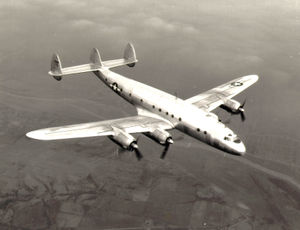Lockheed C-69 Constellation
| C-69 Constellation | |
|---|---|
 |
|
| A C-69 Constellation in flight | |
| Role | Transport |
| National origin | United States |
| Manufacturer | Lockheed |
| Designer | Clarence "Kelly" Johnson |
| First flight | January 9, 1943 |
| Introduction | July 28, 1943 |
| Retired | 1945 (except C-69C) |
| Status | Retired |
| Primary user | United States Army Air Forces |
| Produced | 1942–1945 |
| Number built | 22 |
| Developed from | L-049 Constellation |
The Lockheed C-69 Constellation was a four-engined, propeller-driven transport pressed into military service during World War Two. It was the first military version of the Lockheed Constellation aircraft line. It first flew in 1943, and production of the 22 constructed was shared between the United States Army Air Forces (15) and commercial carriers. Most of the C-69 aircraft built were later converted into civilian airliners under the new designation L-049.
Following the Attack on Pearl Harbor and the United States entering World War II, the assembly lines at the Lockheed Aircraft Corporation were taken over by the American government for the war effort. Along with the assembly lines, the Lockheed L-049 Constellation airliner was also requisitioned and redesignated C-69 and was to be used as an equipment and personnel transport by the United States Army Air Forces (USAAF). In February 1942, the 80 L-049/L-149 Constellations ordered by Transcontinental & Western Air and Pan American World Airways were also requisitioned. The 50 L-049s both airlines had on order were to be redesignated C-69 and C-69A, respectively, and used as troop transport aircraft. The 30 L-149 aircraft Pan Am had on order were replaced by the similar model L-349 (difference being the cargo door on the upper left hand side of the aircraft and the ability to carry cargo) and designated C-69B. Another 180 C-69B aircraft were ordered increasing the figure to 210. Due to the direction the war was heading during summer 1942, the need for a large troop transport capable of crossing the Atlantic Ocean or Pacific Ocean (by flying from island to island) became more important. This would help avoid the risks the convoys in the Atlantic were facing due to U-Boat attacks. The Douglas C-54 Skymaster planned for these roles wasn't completely capable. So on September 29, 1942, the American War Department signed contract W535 AC-26610. With this contract, the nine L-049 aircraft under construction for TWA were purchased and 150 more C-69A and C-69B aircraft were ordered along with C-69C (L-549) and C-69D VIP transport versions. In reality, only one C-69C was produced out of all these planned variants.
...
Wikipedia
